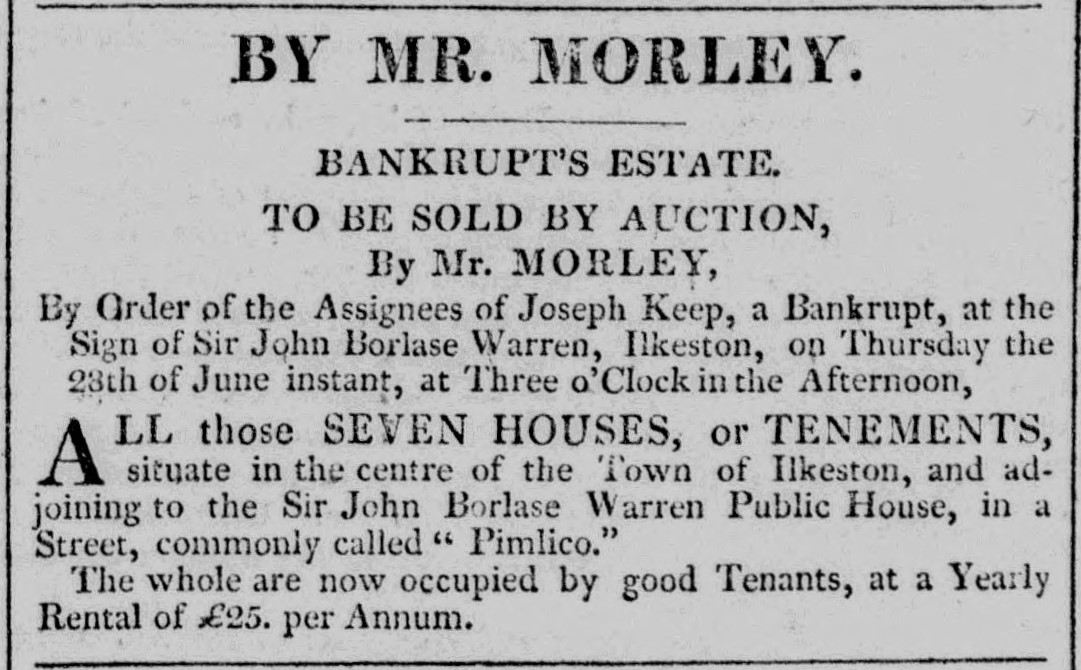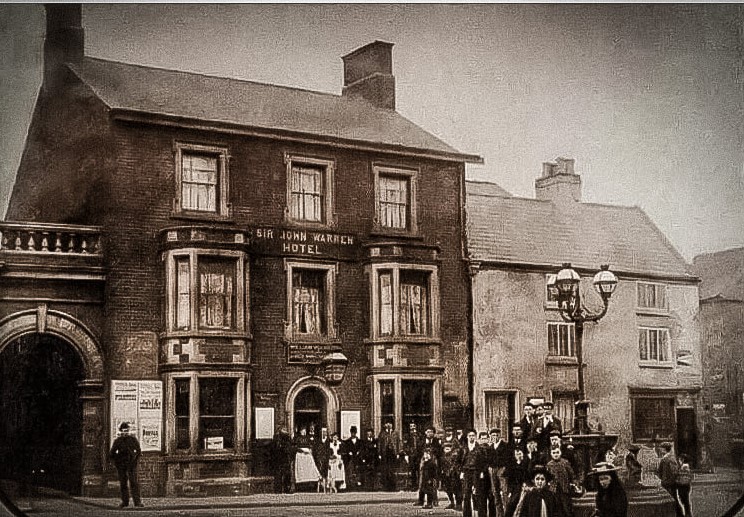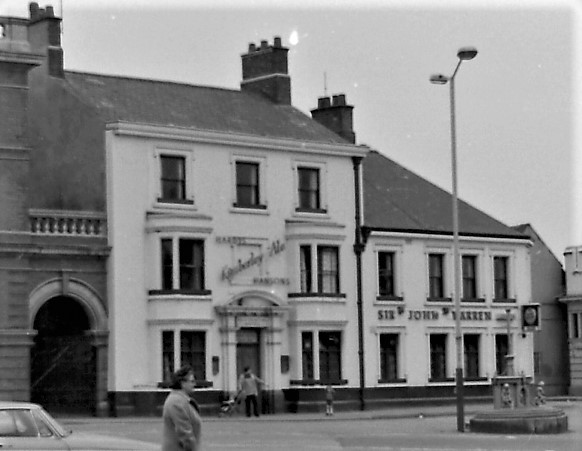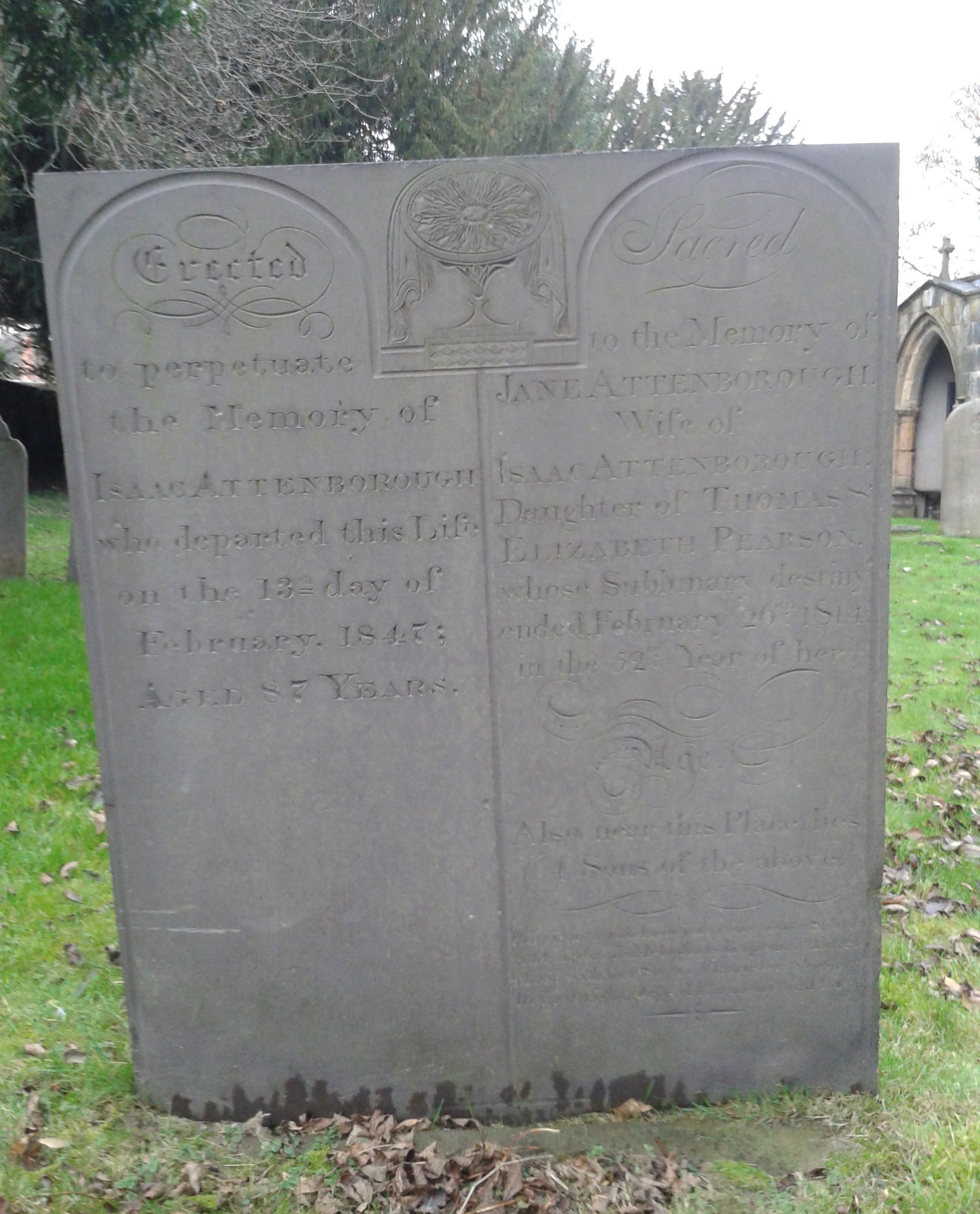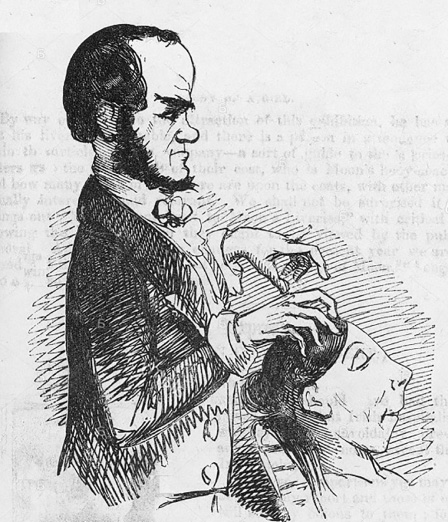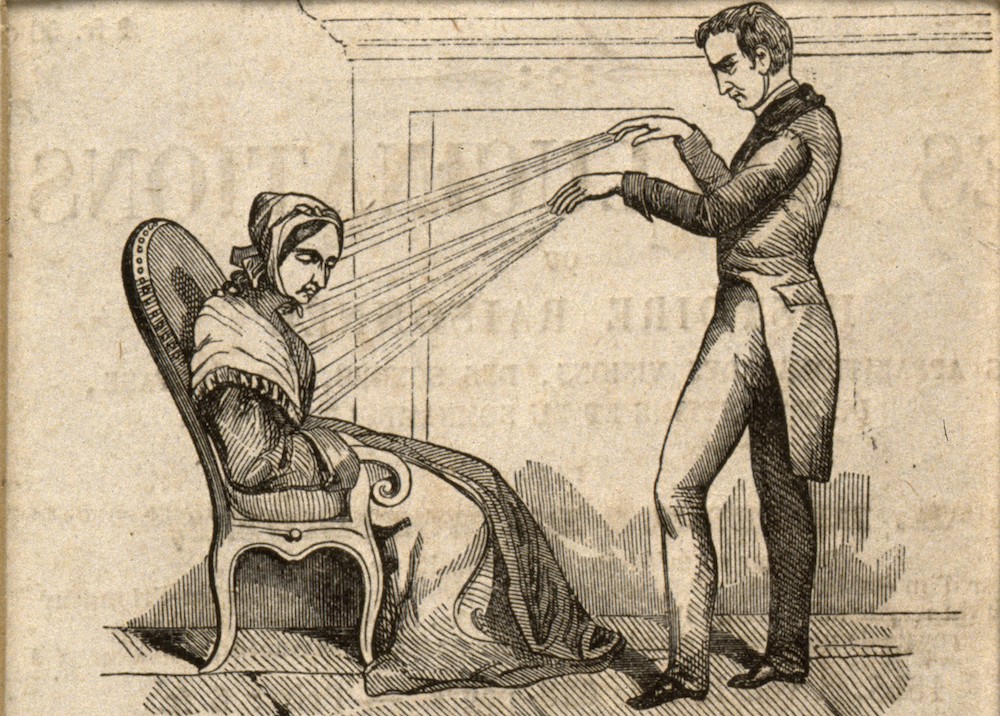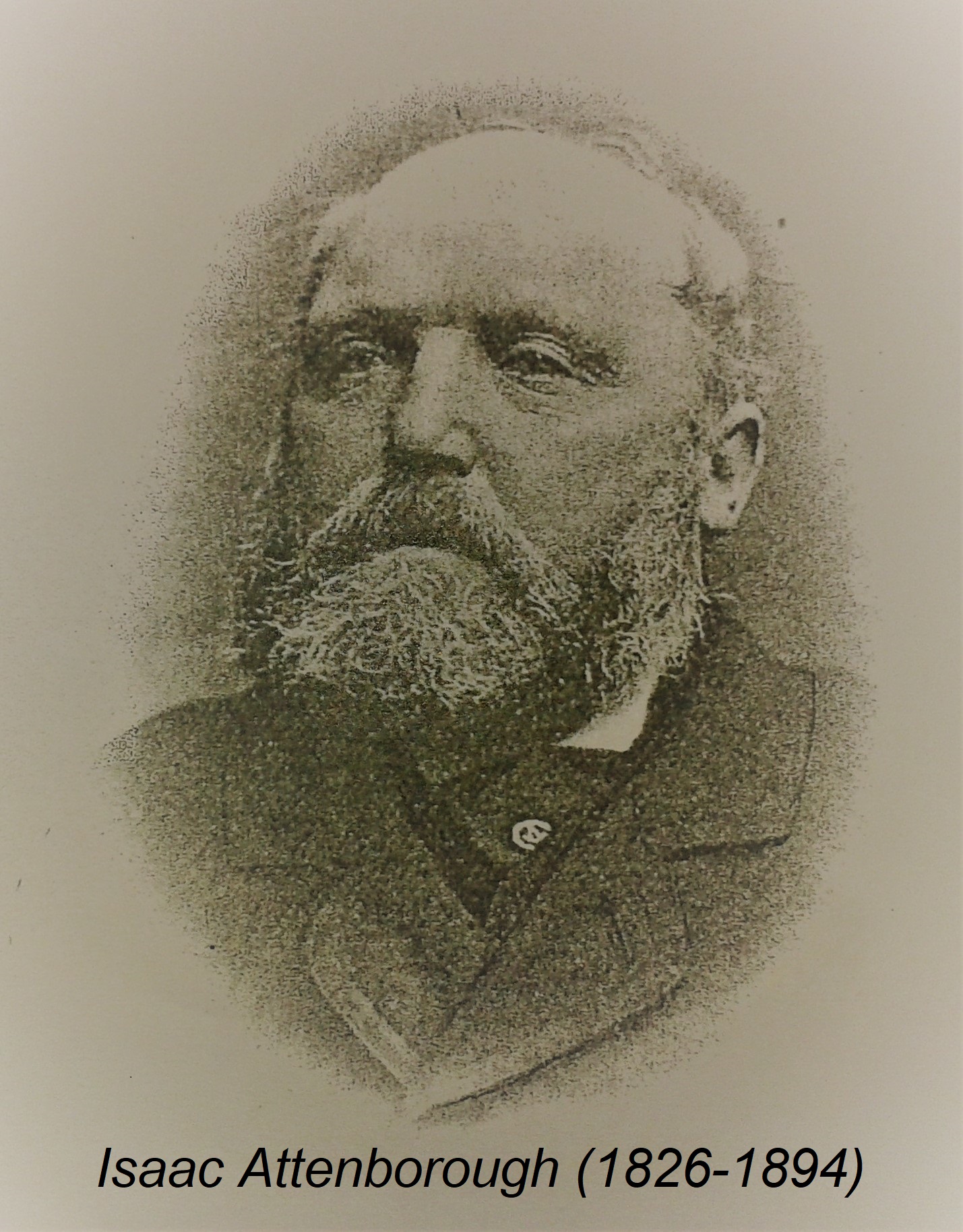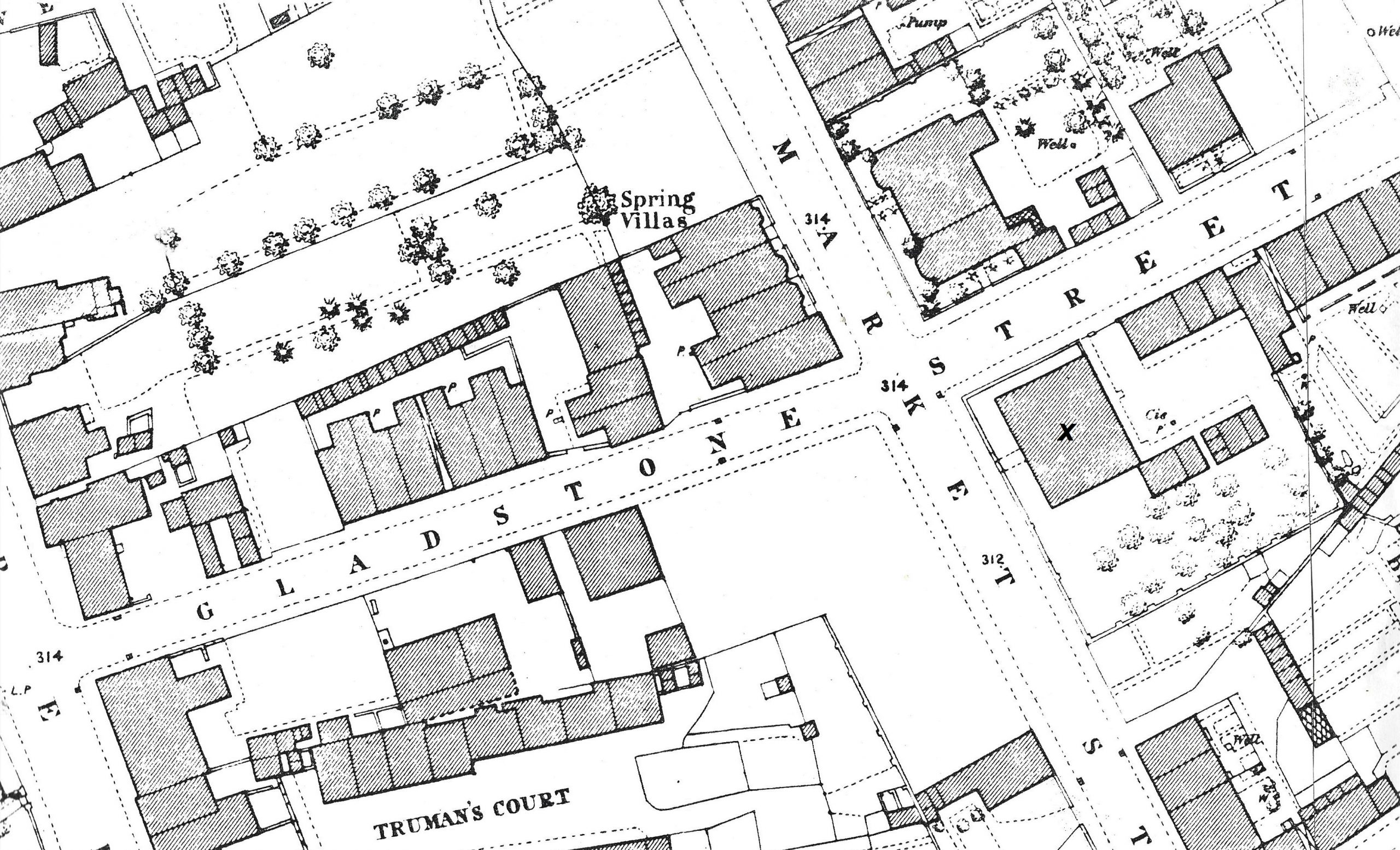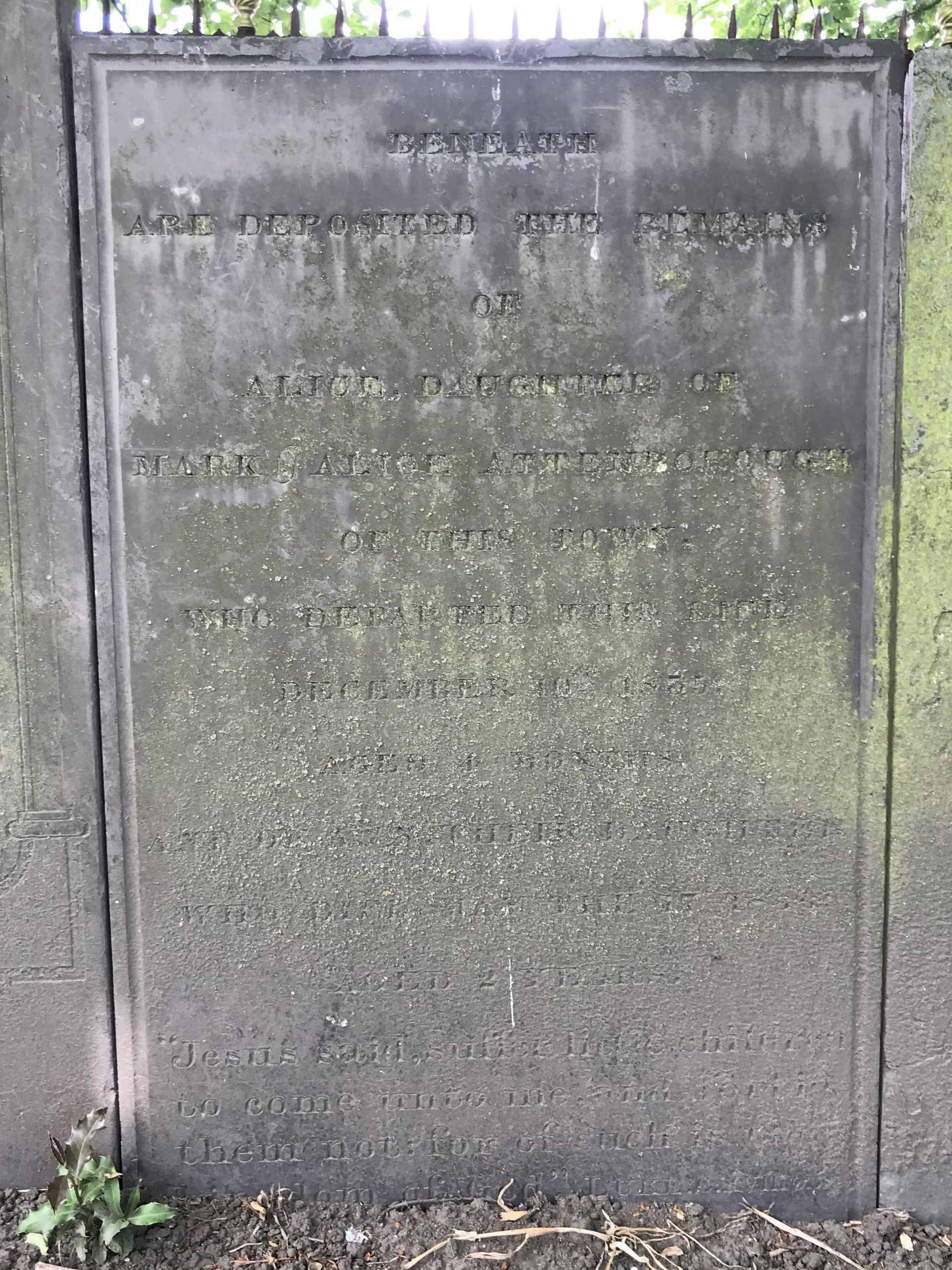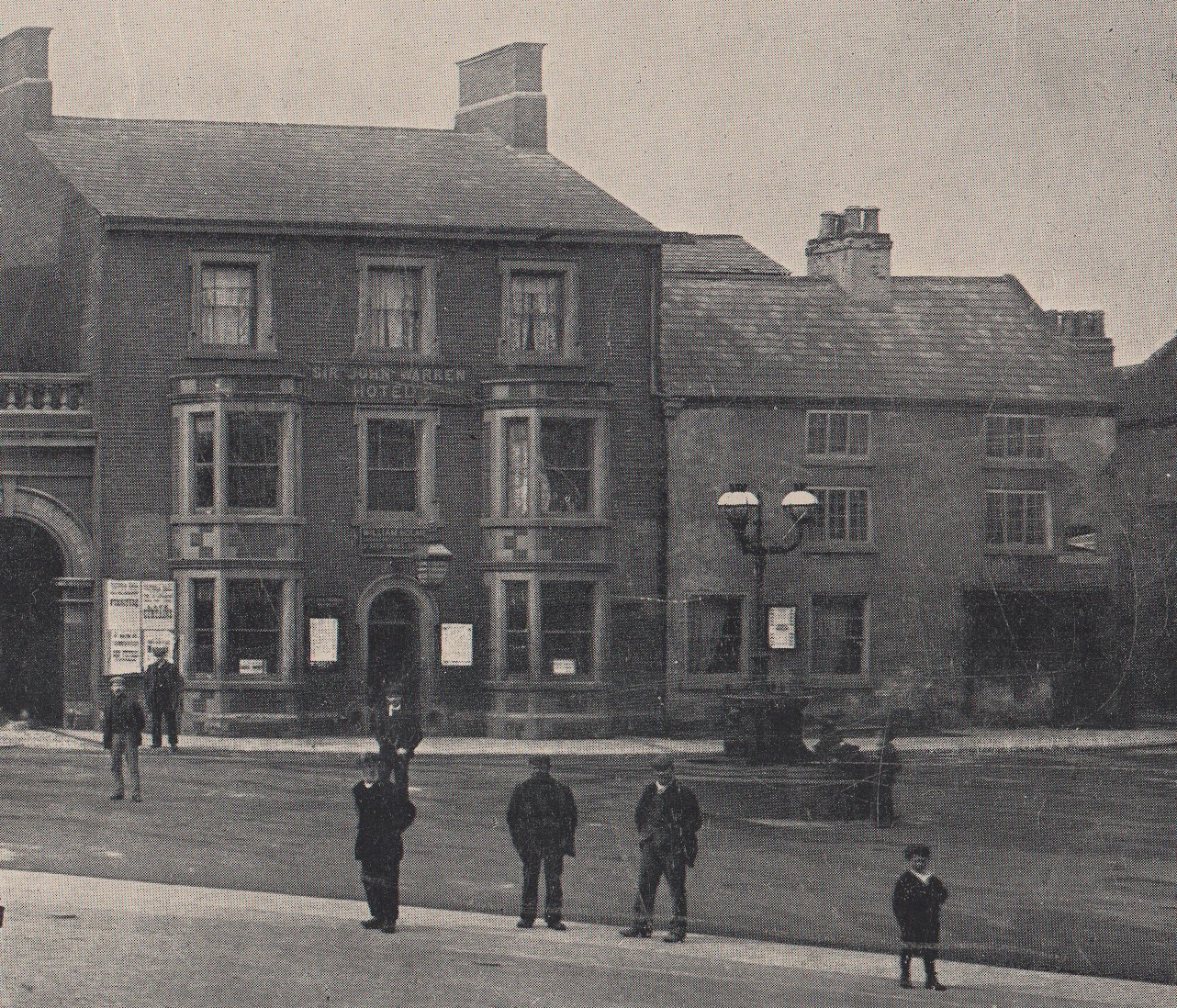As we walk from the Independent Chapel in Pimlico (just off the right of the photo below), towards the Sir John Warren Inn, we notice on our right, a row of seven houses in Pimlico
from the Nottingham Journal (June 16th, 1821)
—————————————————————————————————————————————————–
The Sir John Warren Inn in the late 1890’s (courtesy of Ilkeston Reference Library)
and, below, a more recent and extended version of the inn (Jim Beardsley)
The top photo shows, on the board above the inn’s main entrance, William Holmes as landlord. William was there from 1897 to 1900, before James Frost Wilson took over.
—————————————————————————————————————————————————–
The Attenborough family
In 1797 Isaac Attenborough bought the five cottages on this site (from Samuel Coates of Underwood), pulled down two of them and built stables on their site. He converted the other three into an inn and the family lived there until 1878. (Waterhouse)
This Isaac Attenborough (and there were many of them !!) was born in Stapleford, Nottinghamshire in 1760, the son of John and Margaret (nee Hitchcock). On December 3rd, 1782 he married Jane ‘Jenny’ Pearson of Cossall, Nottinghamshire, a daughter of Thomas and Elizabeth (nee Dennis), and they had at least 11 children, of which Mark was the oldest surviving son.
This gravestone is to be found at St Catherine’s Church, Cossall.
On the left it reads ‘To perpetuate the Memory of Isaac Attenborough who departed this Life on the 13th day of February 1847; Aged 87 Years’.
On the right we see ‘Sacred to the Memory of Jane Attenborough, Wife of Isaac Attenborough, Daughter of Thomas & Elizabeth Pearson whose Sublunary destiny ended February 26th 1814 in the 52nd Year of her Age. Also near this Place lies Sons of the above’.
I believe that Jane Attenborough is buried in St. Mary’s Church, Ilkeston.
—————————————————————————————————————————————————–
Mark Attenborough (1788-1859)
Adeline writes that “the Sir John Warren Inn was the home of the Attenboroughs. Isaac was the landlord. He had three sons, and two daughters”. She seems to be referring not to Isaac but to Mark Attenborough. The latter was the son of Isaac — mentioned by Edgar Waterhouse (above) and whose gravestone we can see (also above). Mark had taken over the Sir John Warren Inn from his father in 1819.
Mark had three sons, Isaac, William and Thomas, and two surviving daughters, Jane and Sarah. His two youngest children, Alice and Ann, died in infancy.
Born in 1788 Mark was a son of farmer and cattle dealer Isaac and Jane (nee Pearson) and is variously described as publican, victualler, maltster, farmer and cattle dealer at Warren’s Arms or the Sir John Warren.
On November 26th, 1825 he married Alice Mitchell eldest daughter of William and Sarah (nee Hously). Her family had moved from Calverton in Nottinghamshire to settle in the Pimlico area of Ilkeston; we shall meet other members of this family shortly.
Alice died on April 1st, 1849 and her husband ten years later, on May 1st, 1859.
Both were buried at St. Mary’s church: their vault can be found in the main churchyard.
Sacred to the memory of the late Mark Attenborough who died May 1st 1859 in the 71st year of his age.
In affectionate remembrance of Alice wife of Mark Attenborough who died April 1st 1849 in the 49th year of her age.
Phreno-magnetism finds a home in Ilkeston
In the Sir John Warren, landlord Mark had a large upstairs room which served many purposes at very special occasions. One such occasion occurred on March 27th, 1843 when Phreno-Magnetism made its first appearance in Ilkeston. In fact this was a very new phenomenon hardly heard of anywhere in the world (though Kimberley in Nottinghamshire had already had a preview !!), and now here it was being discussed in a Market place pub in a very impoverished Derbyshire town. Simply put, it was mixture of two ‘sciences’ — phrenology and mesmerism — and involved stimulating elements of the brain through magnetism or hypnosis.
a mixture of phrenology …
A lecture on this ‘science’ was being given by Dr. George Lucas and a large ‘highly respectable‘ audience had assembled to hear his explanation and witness a sample of associated experiments. The doctor had already given talks on phrenology around the town, in more modest accommodation, with smaller audiences — perhaps now was the time to take a step up ?
Assisting George as the ‘principal operator’ was Mr. Widdowson of Kimberley, repeating his performance of a few days previous, in his home village, and four members of the audience stepped forward to act as guinea pigs. During the demonstration, several instances of involuntary fighting and singing, deep coma and sleepwalking were witnessed.
All profits from the lecture went towards the Artizans’ Library.
A tribute to Mark
Just over six months before his death Mark was presented by members of the Rutland Lodge of Oddfellows, Manchester Unity, with a portrait of himself, the work of John Brassington, portrait painter of Friar Gate, Derby. At the ceremony and presenting the portrait, Dr. Norman spoke warmly of Mark; “none could surpass the integrity and uprightness which had marked Mr. Attenborough’s long career of life… it approved itself to all; to the members of that Lodge especially, whose treasurer he had been for a period of thirty years…”.
Also present at the ceremony was the Rev. Ebsworth, receiving the gift on behalf of Mark – who was too ill to attend — and who added “I believe he has gained the respect of all persons in the parish of every shade of party or politics, and that his character is best told in the words ‘An honest man’s the noblest work of God’. I have no doubt the family will regard the gift as an heirloom, and long cherish the kindly feelings of those by whom it was tendered”.
—————————————————————————————————————————————————–
The children of Mark and Alice
1. Isaac Attenborough (1826-1894)
Trueman (1) records that the eldest child Isaac was born at the hotel on April 2nd 1826 and married Sarah Beardsley of West Hallam on April 7th, 1850. She was the daughter of West Hallam farm labourer Edward and Dorothy, and already had an illegitimate son, Thomas Attenborough Beardsley born in 1843. At least nine further children followed after the marriage.
Isaac was the landlord of the inn after his father Mark, and during his lifetime held many positions of authority — serving as Overseer of the Poor, Guardian of the Poor, Churchwarden, member of the Local Board and its Chairman 1882/3.
On Isaac’s election to the latter position, ‘Rambler’ described him as “one who can point back to many long years of practical work on behalf of the parish – a man of few words, but possessing a decision of character eminently useful in the task of controlling a Board which habitually treats the ordinary rules of debate as a dead-letter, and constantly exhibits a tendency to reopen the discussions of questions already decided”.
The writer concluded that Isaac was “a man of business uninfluenced by those petty considerations which mar the administrations of affairs by those who fix their eyes on party aggrandisement”.
Isaac also acted as treasurer of the Ilkeston Farmers’ Club and was a regular exhibitor at its shows.
He played for the Rutland Cricket Club and was its president in later life.
Isaac’s eldest legitimate son was Mark who was educated at Derby Grammar School and in 1868 passed the Incorporate Law Society’s preliminary legal examination in London. He later served as an articled clerk to Edward Humphreys, his solicitor uncle (by marriage).
Born in 1859 Isaac’s son Edward lived and worked at the Inn. In 1884 he married cotton winder Sarah Ann Walker of Park Road, the daughter of labourer Richard Joseph and Ann Gregorywall Pilkington (nee Bullock). His wife had an eight-month old illegitimate son, Edward Walker. (This son later adopted the name Edward Walker Attenborough and in 1913 he married under that name, citing Edward Attenborough as his father).
About 1888/89 Edward Attenborough became landlord of the Horse and Groom Inn at Gallows Inn and died there in 1890, another Ilkeston victim of cirrhosis of the liver.
In 1898 his widow married stationary engine driver and widower David Short.
Daughter Alice Ann married Pimlico builder John Wheatley in August 1884.
Isaac and Sarah had at least six other children but they all died very young… Alice in 1851, aged 15 months; Jane in 1858, aged nearly four years; Sarah in 1858, aged 15 months; Isaac junior in 1862, aged five months; Arthur William in 1869, aged four years and two months; and John in 1878, aged eight years.
In the autumn of 1878 Isaac began to build a large house with a substantial area of open ground on its south side, on the south-east corner of the Gladstone Street and Market Street crossroads, for his family and subsequently moved there. You can see it on the map below, marked X, just a couple of years after it was built. It was Number 15 Market Street.
It incorporated a dining room, drawing room, seven bedrooms, bathroom, three store rooms, entrance hall with vestibule, kitchen, larder and a store. Outside there were stables, with a store above them, a carriage house, a shed, wash-house and other outoffices.
His wife Sarah died at that home on February 9th, 1890 and in the following year Isaac married his second wife, his housekeeper Lydia Duro, daughter of Mapperley coalminer Joseph and Ann (nee Beardsley) and 44 years his junior.
Lydia’s mother was the sister of Isaac’s first wife.Thus his sister-in-law became his mother-in-law, and his niece by marriage became his wife.
On February 4th, 1892 Lydia gave birth to William Attenborough.
When the town was incorporated in 1887, Isaac tried to win a seat on the new Town Council but was unsuccessful, and thereafter led a quiet, private life, pursuing his passion for farming.
Isaac died at his home in Market Street on August 3rd, 1894. Four months later his estate was put up for sale by George Haslam. This included his Market Street home and the land to the south of the home (372 square yards), fronting Market Street and suitable as building land. The copyhold Horse and Groom Inn at Gallows Inn was still in Isaac’s hands when he died and this too was to be sold off, as well as two crofts of pasture land — one adjoining the inn and the other on the other (west) side of the Erewash Canal and so separated from the inn — both then being used by Severn Beer, the Inn’s landlord. There were two cottages at the rear of the Inn, with gardens and out-buildings, occupied by Hannah Lawton (nee Smedley), the widow of labourer Thomas, and her family — also for sale. The Erewash Canal Company paid a yearly rent for use of this land and that, too, was included. Finally, Isaac owned a piece of freehold building land on the south side of Nottingham Road, opposite the Horse and Groom, and this, too, was up for sale. (A map of the Horse and Groom and surrounding land can be found here)
Four years after Isaac’s death his widow Lydia married lacemaker George Spencer who at the turn of the century was the landlord at the Borough Arms in Bath Street.
In 1897 the eldest son of Isaac and Sarah — Mark Attenborough (born March 13th, 1852) — presented two candle standards to St. Mary’s Church, in memory of his parents.
2. Adeline recalls that “sons William and Thomas were noted cricketers”
It is unlikely that these two sons, cricketers William and Tommy, got knowledge of the game from father Mark who possibly didn’t know which end of a cricket bat to hold.
Second son William was a good local cricketer, a left-handed bowler and batsman, but it was younger brother Tommy who stood out at the sport. We shall meet Tommy again at the Gallows Inn end of Nottingham Road.
We shall also meet his brother William in Nottingham Road. (See the Horse and Groom Inn).
3. And Adeline tells us that “Jane married Mr. Joseph Carrier, draper, Bath Street”.
Daughter Jane married Joseph Carrier, youngest child of hosier Henry and Elizabeth (nee Smith) in July 1851 and went to live in Bath Street.
4. “Sarah became the wife of Mr. Humphrey, a solicitor in London”.
Daughter Sarah married Edward Humphreys, solicitor‘s clerk and later solicitor, in April 1861 before moving to London.
5. The two youngest daughters were Alice who died in September 1835, aged 4 months, and Ann who died in 1840, aged 2 years.
A rather large stone for two very short lives.
It stands in the north side of the main graveyard, overlooking the lower Market Place.
The inscription reads …
“Beneath are deposited the remains of Alice daughter of Mark and Alice Attenborough of this town who departed this life December 10th 1835 aged 4 months and of Ann their daughter who died May 17th 1840 aged 2 years
Jesus said suffer the little children to come unto me and forbid them not for of such is the kingdom of God. Luke CXXVIII.”
—————————————————————————————————————————————————–
In the latter half of 1879 William Ball became landlord and in February 1882 the licence was transferred to Edwin Hall. He was still there in 1888 but by 1890 the licence had been transferred to Arthur Tinsley who was there in July 1896 when the Inn was put up for auction.
Who could resist ??!! … it had a taproom, smoke-bar, private taproom, parlour, kitchen, scullery, dairy, a fine entrance and staircase, billiard room, a large clubroom, a private sitting room, nine bedrooms, a storeroom, w.c. etc., three excellent cellars cut into rock, a brewhouse, coal store, out offices, standing for 12 horses, two cart sheds, a hayloft, pigstyes, and large open yards. The lease was to expire in two months time. Along with the inn was the grocer’s shop and house at number 1 Market Place, and two houses round the corner at number 1 and 2 Pimlico. The solicitor arranging the sale was Mark Attenborough of Walbrook, London — son of Isaac junior, grandson of Mark and great grandson of Isaac senior.
It was sold for £8250 on July 16th, 1896 to brewer Thomas Hardy of Kimberley, Notts.
When the lease expired, in October 1896, the Inn’s licence was temporarily transferred from Arthur Tinsley to J.Kendall.
By 1898 William Holmes was the landlord, a man who, it seems, enjoyed consuming what he was selling. On the evening of December 30th, 1898 he had turned up at the Sun Inn in Eastwood, somewhat the worse for drink. The landlord John Smedley thus refused to serve him but William persisted, on several occasions, to gain entry to the pub. Eventually the police were called and soon lost patience with William; he was carried off towards the police station but on the way, he threw himself on the floor and refused to go any further. At some point he was alleged to have used his shoulder against one officer and kicked another on his shin. William then finished the rest of the journey in a milk cart. Once in the cells he continued shouting, kicking the door and at one point caught another officer on the thigh — another alleged assault.
After being given time to sober up in the cells, he was released and arrived back at his own pub — which he was allowed to enter !! –at 2 o’clock the next morning. A month later, when William appeared at the Police Court in Nottingham, the magistrates were not convinced of the charge of common assault on the police which was dismissed, though the charge of being drunk and disorderly brought a fine of 12s 6d with all costs which totalled £10 3s 6d !!!
On the 1901 census James Frost Wilson is the licensed victualler there.
Courtesy of Ilkeston Reference Library
So now, with all the information on this page, you might be able to date the top and bottom photos to a year or two (after enlargement ?)
———————————————————————————————————————————————
The shop and dwelling house at No, 1 Market Place, are to the right in the photos directly above and at the top, and the dwelling houses at Nos 1 and 2 Pimlico, are just round the corner to the extreme right.
—————————————————————————————————————————————————–
Next door to the Warren were at one time a row of cottages.

